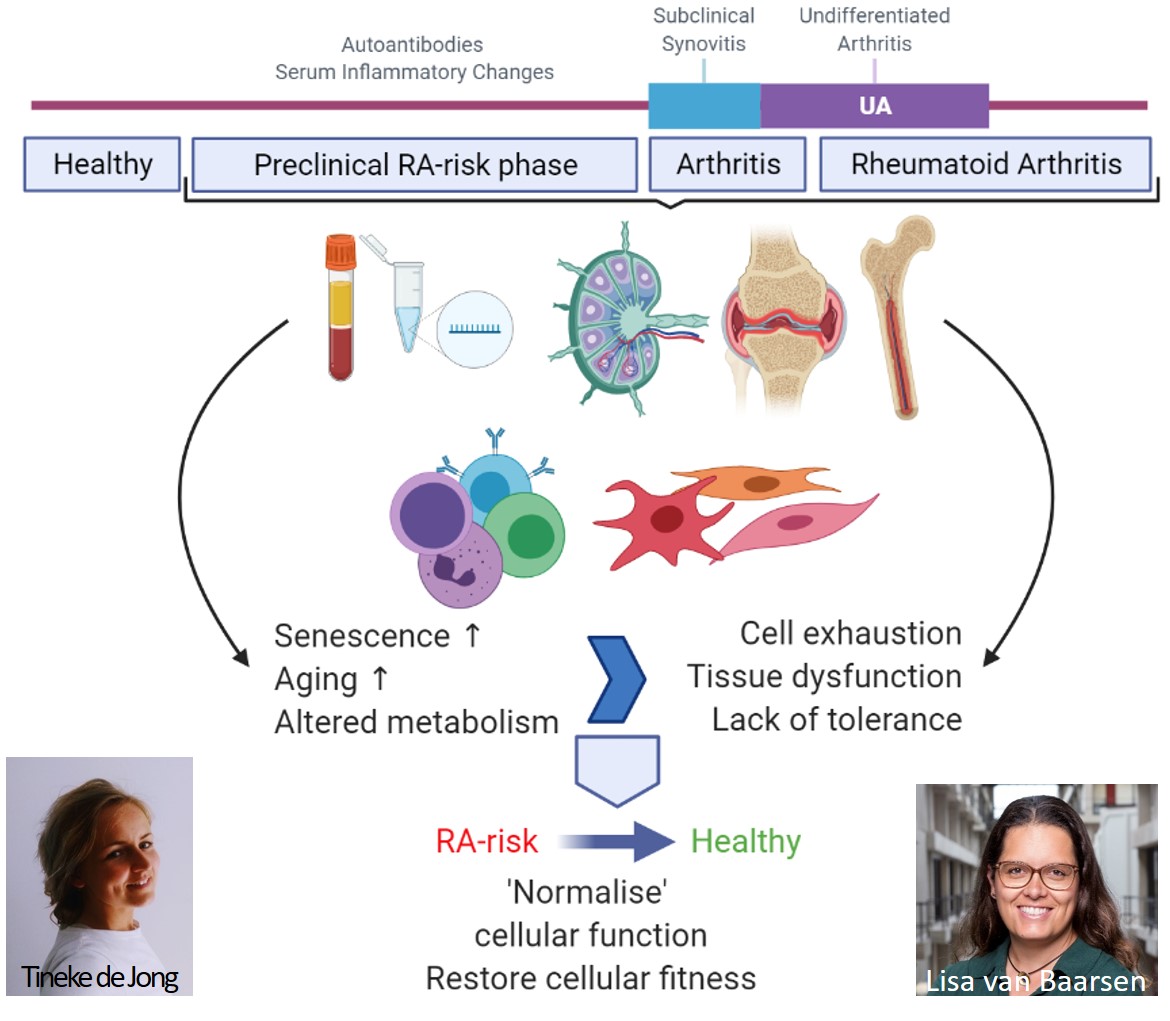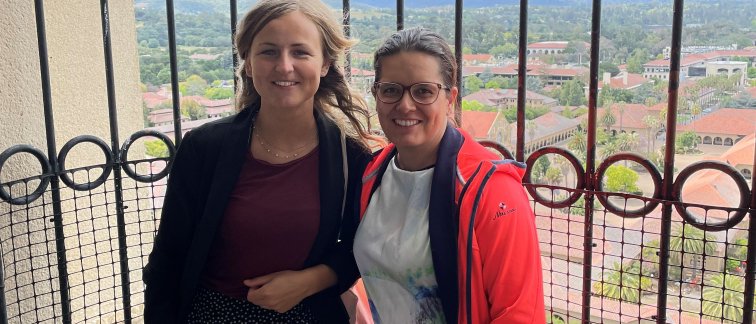Altered synovial gene signatures are detectable in individuals at risk of rheumatoid arthritis, which are associated with development of disease months to years later. This was demonstrated by Lisa van Baarsen's research group in their most recent publication called "Synovial gene signatures associated with the development of rheumatoid arthritis in at risk individuals: A prospective study”. In the article below, Dr. Van Baarsen talks about this discovery and her plans for follow-up research.
Lisa van Baarsen has been head of her research group since 2011. Her group focuses
on research into the pre-clinical phase of rheumatoid arthritis. This is the
phase when antibodies are detectable but people do not yet show disease
symptoms. It is known from research that around 30% of these people develop
rheumatoid arthritis within two to five years. The main question at play within
Dr. Van Baarsen’s research group: why do some people develop rheumatoid arthritis
and others not? Recently, Lisa van Baarsen's research group came another step
closer to answering this question. They published these results in the article:
Synovial gene signatures associated with the development of rheumatoid
arthritis in at risk individuals: A prospective study.
Unique, long term studies
Lisa van Baarsen: "The studies we conduct within my research group are unique, long term tissue-based studies. Participants who participate do so for quite some time, during this participation they donate synovium, blood, and/or lymph node samples. Our ultimate goal is to be able to understand at the cellular level what happens in people who do develop rheumatoid arthritis from the pre-clinical stage and the group where this does not happen."
Cellular level understanding
To achieve this understanding at the cellular level, detailed analyses of synovium and lymph node tissue biopsies are necessary. Lisa van Baarsen: "People sometimes say that this is an invasive way of doing research. However, in previous research from my department, we contrasted synovium biopsies with an MRI scan, in which some participants preferred the biopsy afterwards. In addition, lymph node biopsy studies are within rheumatology seen as a new, invasive way of doing research. While in oncology it is a standard diagnostic procedure. In my opinion, this is also a suitable research method in rheumatology, provided you can get the logistics set up."
Synovial gene signatures
Lisa van Baarsen: “Our objective for the current study was to identify molecular changes in synovium before arthritis development in individuals at risk of developing rheumatoid arthritis. We included a cohort of 67 participants who tested positive for rheumatoid factor and/or anti-citrullinated protein antibodies, characteristic for the pre-clinical stage of rheumatoid arthritis (see figure 1 for a visual representation of the project). Synovial biopsies were collected after which participants were followed for two years. Within this group, we saw clear "gene signature" differences between people who did and did not develop rheumatoid arthritis. What we saw was that there were differences in expression levels of genes involved in immune activation and lipid metabolism."
 Figure 1. Visual representation of Lisa van Baarsen's research project
Figure 1. Visual representation of Lisa van Baarsen's research project
For immune activation, Dr. Van Baarsen and colleagues expect joint inflammation to be caused by a combination of genes and environment. According to them, the observed immune activation genes in combination with a potential ‘second hit’ by e.g. trauma or viral infection may contribute to the development of rheumatoid arthritis. Lisa van Baarsen: "I am currently investigating with Prof. dr. Riekelt Houtkooper, Amsterdam UMC Laboratory Genetic Metabolic Diseases and specialized in mitochondrial metabolism, what the reduced activation of lipid metabolisms means. For this we are isolating fibroblasts from the synovium to see if metabolism differs for participants who do or do not develop rheumatoid arthritis. Initial results seem to indicate that metabolism is impaired in synovial fibroblasts of participants who are at risk of rheumatoid arthritis, soon to be published in the Journal of Autoimmunity. Whether these metabolic and immune differences are related with each other is a follow-up question."
Preventive therapy for high-risk individuals
The ultimate goal of Lisa van Baarsen and colleagues is to find novel targets for the development of preventive therapy for high-risk individuals. Dr. Van Baarsen: "We are already looking at what is most likely to succeed as preventive therapy. Here we involve high-risk individuals and patients with rheumatoid arthritis. We find out what their wishes, requirements, conditions and preferences are for preventive treatment. Questions that are addressed are for example: how high should your risk be before starting preventive treatment, and what kind of treatment strategy would be acceptable? We discuss this together, also with other internationally renowned scientists and rheumatologists in the field, so we can ultimately develop the best clinical trial for testing preventive treatment strategies."
Collaboration is key
Lisa van Baarsen: "This research would never be possible without the fantastic teamwork of my research group together with colleagues from our multidisciplinary department of Rheumatology and Clinical Immunology, the department of Radiology, and the laboratory of Experimental Immunology. As research team we arrange the whole study together, from patient recruitment, to biopsy collection to analysis in the lab as well as dissemination to the public including patients.
Next to collaborating with researchers within the Amsterdam Institute for Infection and Immunity, Dr. Van Baarsen seeks collaboration with other research groups within the Amsterdam UMC. She currently has ongoing collaborations with researchers linked to Amsterdam Gastroenterology Endocrinology Metabolism (AGEM) and Amsterdam Movement Sciences (AMS). With the researchers of AGEM, Dr. Van Baarsen investigates cellular metabolism and aging, and with researchers of AMS she aims to study tissue function and regeneration. Lisa van Baarsen: "During a presentation by Prof. dr. Richard Jaspers I learned that at AMS they are also studying the age-related decline in vitality of musculoskeletal tissues. That was exactly where I wanted to go with my research: to make the link between accelerated aging of tissue cells and its impact on the immune response. I recently joined AMS myself to steer this research project in the right direction.”
What’s next?
So far, blood, synovium and lymph node biopsies have been collected for the current studies of Dr. Van Baarsen. Recently, Lisa van Baarsen and colleagues received METC approval to take bone marrow aspirates and bone biopsies in a follow-up study. Dr. van Baarsen: "Again a procedure that is already being used in oncology. With this study, we can determine if immunological processes taking place in bone marrow, which are crucial for immune cell development and survival, play a role in the development of rheumatoid arthritis."
In addition, Dr. Van Baarsen wants to focus on restoring the function of cells where things go wrong in the development of rheumatoid arthritis. Dr. Van Baarsen: "For the lymph node studies I have a longstanding collaboration with Prof. dr. Reina Mebius on lymph node stromal cells. We hypothesize that early in the developmental process of rheumatoid arthritis these cells are malfunctioning leading to uncontrolled immune cell activation. Normalizing this aberrant stromal cell function is one of our goals. In the area of cellular metabolism and aging, I want to start investigating how we can influence these processes and to rejuvenate the cells in order to restore tissue function. As you can already hear: plenty of work to do."
Lisa van Baarsen’s wish for the future: availability and affordability of state-of-the-art infrastructure necessary for translational tissue-based studies like this. Dr. Van Baarsen: "Costs keep rising. And as difficult as it is, you have to remain innovative as an institute, otherwise you will fall behind. Innovation is key."
Get to know Lisa
Lisa van Baarsen is Principal Investigator at Amsterdam UMC. Within her work she gives considerable attention to supervising PhD students. She looks beyond the 'PhD thesis'; what Dr. Van Baarsen finds important is the ambition and personal development of the PhD student self. She feels that a successful PhD supervision is also about guidance in finding the right career step after the PhD trajectory.
In addition to her work as Principal Investigator, Lisa van Baarsen is part of the internal research support of Amsterdam UMC, where she advices researchers applying for grants. Furthermore, she is a member of the ZonMw Veni Committee, the AII grant committee, and the Scientific Advisory Board of ReumaNederland. In her spare time, she can be found at the St. Mauritius gymnastics club, of which Dr. Van Baarsen is the chairwoman. She also enjoys spending time with her family and raising two active boys.
For more information contact Dr. Lisa van Baarsen or read the scientific article here.
Curious to learn more about rheumatoid arthritis? Read it here:
Text: Esmée Vesseur
Photo (from left to right): Tineke de Jong (first author of the article) and Lisa van Baarsen at the Stanford campus where Tineke is currently working as a Postdoc researcher.

